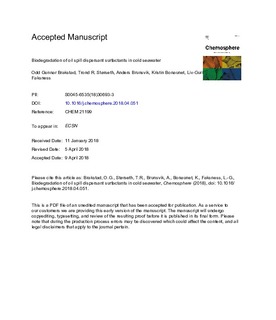| dc.contributor.author | Brakstad, Odd Gunnar | |
| dc.contributor.author | Størseth, Trond Røvik | |
| dc.contributor.author | Brunsvik, Anders | |
| dc.contributor.author | Bonaunet, Kristin | |
| dc.contributor.author | Faksness, Liv Guri | |
| dc.date.accessioned | 2018-05-22T11:22:17Z | |
| dc.date.available | 2018-05-22T11:22:17Z | |
| dc.date.created | 2018-04-11T23:29:20Z | |
| dc.date.issued | 2018 | |
| dc.identifier.citation | Chemosphere. 2018, 204 290-293. | nb_NO |
| dc.identifier.issn | 0045-6535 | |
| dc.identifier.uri | http://hdl.handle.net/11250/2498697 | |
| dc.description.abstract | While biodegradation of chemically dispersed oil has been well documented, only a few studies have focused on the degradation of the dispersant compounds themselves. The objective of this study was to determine the biodegradation of dispersant surfactants in cold seawater, relevant for deep sea or Arctic conditions. Biotransformation of the surfactants dioctyl-sodium sulfosuccinate (DOSS), Tween 80, Tween 85, and α/β-ethylhexylsulfosuccinate (EHSS, expected DOSS hydrolysis product) in the commercial dispersants Corexit 9500, Dasic Slickgone NS and Finasol OSR52 were determined. The biotransformation studies of the surfactants were performed in natural seawater at 5 °C over a period of 54 days without oil present. The surfactants were tested at concentrations of 1, 5, and 50 mg/L, the lower concentration being as close as possible to expected field concentrations. Experiments with dispersants concentrations of 1 mg/L resulted in rapid biotransformation of Tween 80 and Tween 85, with depletion after 8 days, while DOSS showed rapid biotransformation after a lag period of 16 days. The degradation half-life of DOSS increased from 4.1 days to >500 days as Corexit 9500 concentrations went from 1 mg/L to 50 mg/L, emphasizing the importance of performing experiments at dispersant concentrations as close as possible to environmentally relevant concentrations. EHSS showed limited degradation compared to other surfactants. This study shows that the surfactants DOSS, Tween 80 and Tween 85 in the three chemical dispersants studied are biodegradable in cold seawater, particularly in environmentally relevant concentrations | nb_NO |
| dc.language.iso | eng | nb_NO |
| dc.rights | Attribution-NonCommercial-NoDerivatives 4.0 Internasjonal | * |
| dc.rights.uri | http://creativecommons.org/licenses/by-nc-nd/4.0/deed.no | * |
| dc.subject | Oil spill dispersants | nb_NO |
| dc.subject | Surfactants | nb_NO |
| dc.subject | Biotransformation | nb_NO |
| dc.subject | Seawater | nb_NO |
| dc.subject | Low temperature | nb_NO |
| dc.title | Biodegradation of oil spill dispersant surfactants in cold seawater | nb_NO |
| dc.title.alternative | Biodegradation of oil spill dispersant surfactants in cold seawater | nb_NO |
| dc.type | Journal article | nb_NO |
| dc.type | Peer reviewed | nb_NO |
| dc.description.version | acceptedVersion | nb_NO |
| dc.rights.holder | © 2018 Elsevier Ltd. All rights reserved - Accepted manuscript © the author(s) 2018 | nb_NO |
| dc.source.pagenumber | 290-293 | nb_NO |
| dc.source.volume | 204 | nb_NO |
| dc.source.journal | Chemosphere | nb_NO |
| dc.identifier.doi | 10.1016/j.chemosphere.2018.04.051 | |
| dc.identifier.cristin | 1578887 | |
| cristin.unitcode | 7566,6,0,0 | |
| cristin.unitcode | 7401,80,1,3 | |
| cristin.unitname | Miljøteknologi | |
| cristin.unitname | Massespektrometri | |
| cristin.ispublished | false | |
| cristin.fulltext | postprint | |
| cristin.qualitycode | 1 | |

